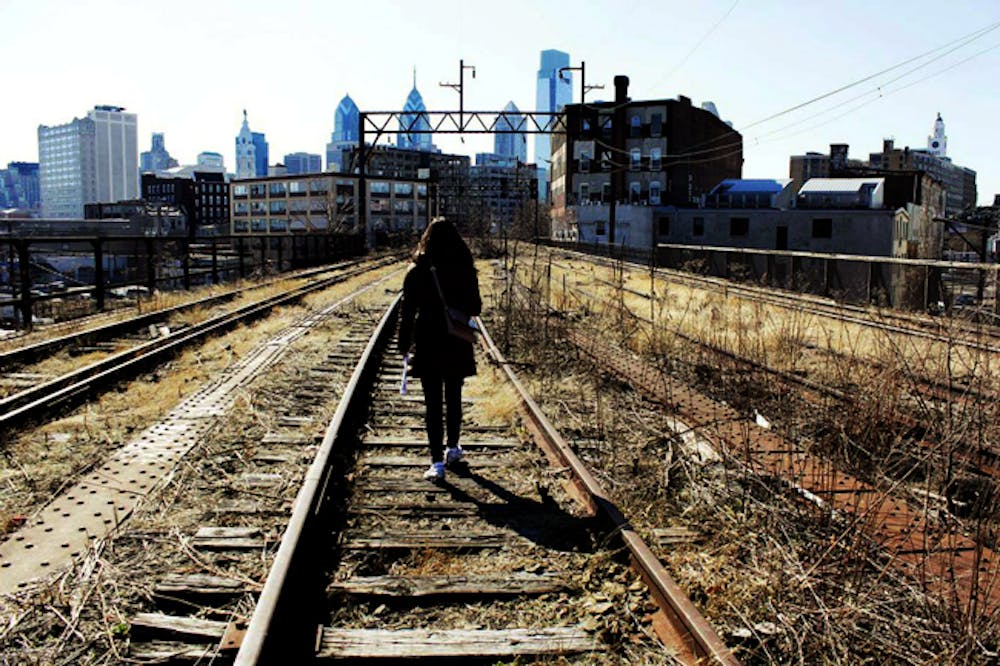Name and Year: Susan Kolber, 2012 Hometown: Chicago, Illinois Major: Architecture Visit above | below | beyond online: http://abovebelowbeyond.org/ Facebook: http://www.facebook.com/AboveBelowBeyond Pinterest: http://pinterest.com/susankolber/above-below-beyond/ Kickstarter: http://kck.st/Qodke6
Street: How did you find out about the Reading Viaduct? What drew you to the space? Susan Kolber: Our architecture studio in the spring created designs for this rail corridor. We had our first tour in February and we walked from the new Barnes Foundation to Chinatown via the railroad path. It's hard not to be completely thrilled about the space—the changes in elevation, the amazing views, wild ecology and the connectivity potential. I have never walked through a beautiful, quiet tunnel, a submerged forest and an elevated open plane on one connected urban walk—this corridor provides such amazing experiences.
I couldn't walk away from my final architecture studio without trying to advocate for this space, and neither could two students at Temple University, Amy Syverson (Temple '12) and Diana Fernandez (Temple '12). We joined forces to organize above | below | beyond—an exhibition of student designs for Philadelphia's three–mile–long rail corridor, with hopes of inspiring people about the potential through the lens of student work.
Street: What's your favorite part of the project? SK: That there's so much opportunity and the whole city could be involved in the future design of this unused rail corridor—I love walking this rail corridor and I think a greater community should be able to enjoy it.
Street: How did you become interested in architecture and planning? SK: I have gone through phases of uncertainty about what “work” makes me happiest. However, I think actually I’ve always had a deep interest in space and design. When I was young, I liked looking at real estate listings in newspapers and magazines and imagining different homes, and I also enjoyed building “forts” in whatever parks I was playing in. Although by the time I started applying to colleges, in my “why Penn” essay, “architecture” was probably the only subject I didn’t list in my potential majors.
After freshman year, with an eclectic course load and no obvious direction, I just barely signed up for the sophomore year Architecture 201 studio and it completely exposed me to the fulfillment and enjoyment of the design process—inventing, re–designing and fabricating. Not to mention you have a personal relationship with all of your professors, have incredible resources at PennDesign and access to sophisticated software and PennDesign’s fabrication lab (a tool shop heaven). By the second semester, you are using chop saws and laser cutters. I could go on forever—I’m so appreciative I was part of the architecture program. The past year especially, I’ve been introduced to amazing practices and business models that are inventing new possibilities for the role of architect.
Now I’m finishing my last semester, trying to complete a few minors in other areas of interest.
Street: When you’re not planning a new future for Philly’s landscape, what do you like to do in your spare time? SK: Take photos, share meals with friends and go on adventures with people. Aside from this railroad, there is an awesome abandoned cemetery called Mount Moriah in West Philadelphia. I advise everyone to check out that out too. Sometimes I volunteer at the cemetery.
Street: Where do you get your inspiration for your designs? SK: It’s different for every project. For the railroad design I was amazed by the wild ecology of the unused railroad and the culture of the neighborhood. For above | below | beyond, the opportunity to collaborate with Diana and Amy from Temple and show people this amazing urban corridor through the lens of student designs makes me excited.
Street: Favorite city in the world, and why? SK: I have had wonderful experiences in Mexico City and Chicago, but right now Philadelphia is my favorite. Obviously I have an emotional attachment to the city, as most of my adult life has been spent here. Philadelphia is walkable, affordable, has an amazing history, awesome food, great people, has convenient access to the “outdoors,” is located between DC and NYC and most importantly, has amazing potential. The opportunity of a space in Philadelphia and the creative community who are taking on the challenging issues facing the city are unique to Philadelphia.
Street: If you could design anything, anywhere, what would it be? SK: Two ideas come to mind—I live in Hamilton Court, and it actually had an amazing courtyard at one point, but now it’s a paved parking lot/garbage collector. That would be an awesome space to re–invent, or I would like to design my parents’ backyard in Chicago.







